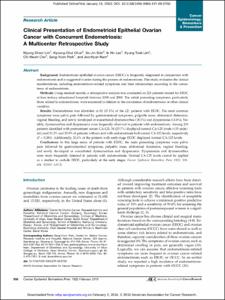KUMEL Repository
1. Journal Papers (연구논문)
1. School of Medicine (의과대학)
Dept. of Obstetrics & Gynecology (산부인과학)
Clinical Presentation of Endometrioid Epithelial Ovarian Cancer with Concurrent Endometriosis: A Multicenter Retrospective Study
- Keimyung Author(s)
- Shin, So Jin; Cho, Chi Heum
- Department
- Dept. of Obstetrics & Gynecology (산부인과학)
- Journal Title
- Cancer Epidemiology, Biomarkers & Prevention
- Issued Date
- 2010
- Volume
- 19
- Issue
- 2
- Abstract
- Background: Endometrioid epithelial ovarian cancer (EEOC) is frequently diagnosed in conjunction with endometriosis and is suggested to arise during the process of endometriosis. This study evaluates the clinical manifestations, including endometriosis-related symptoms and their relationships according to the coexistence of endometriosis.
Methods: Using medical records, a retrospective analysis was conducted on 221 patients treated for EEOC at four tertiary educational hospitals between 2000 and 2008. The initial presenting symptoms, particularly those related to endometriosis, were examined in relation to the coexistence of endometriosis or other clinical variables.
Results: Endometriosis was identified in 82 (37.1%) of the 221 patients with EEOC. The most common symptoms were pelvic pain followed by gastrointestinal symptoms, palpable mass, abdominal distension, vaginal bleeding, and newly developed or exacerbated dysmenorrhea (18.1%) and dyspareunia (13.6%). Notably, dysmenorrhea and dyspareunia were frequently observed in patients with endometriosis. Among 210 patients identified with pretreatment serum CA-125, 54 (25.7%) displayed normal CA-125 levels (<35 units/mL) and 23.3% and 29.9% of patients without and with endometriosis had normal CA-125 levels, respectively (P = 0.381). Additionally, 32.6% of the patients with early-stage EEOC displayed normal CA-125 levels.
Conclusions: In this large series of patients with EEOC, the main presenting symptoms were pelvic pain followed by gastrointestinal symptoms, palpable mass, abdominal distension, vaginal bleeding, and newly developed or exacerbated dysmenorrhea and dyspareunia. Dyspareunia and dysmenorrhea were more frequently detected in patients with endometriosis. Normal CA-125 levels cannot be applied as a marker to exclude EEOC, particularly at the early stages.
Keywords : ovarian cancer; endometriosis; symptoms; endometrioid carcinoma; early diagnosis
- Publisher
- School of Medicine
- Citation
- Myong Cheol Lim et al. (2010). Clinical Presentation of Endometrioid Epithelial Ovarian Cancer with Concurrent Endometriosis: A Multicenter Retrospective Study. Cancer Epidemiology, Biomarkers & Prevention, 19(2), 398–404. doi: 10.1158/1055-9965.EPI-09-0750
- Type
- Article
- ISSN
- 1055-9965
- Appears in Collections:
- 1. School of Medicine (의과대학) > Dept. of Obstetrics & Gynecology (산부인과학)
- 파일 목록
-
-
Download
 oak-aaa-00767.pdf
기타 데이터 / 259.14 kB / Adobe PDF
oak-aaa-00767.pdf
기타 데이터 / 259.14 kB / Adobe PDF
-
Items in Repository are protected by copyright, with all rights reserved, unless otherwise indicated.